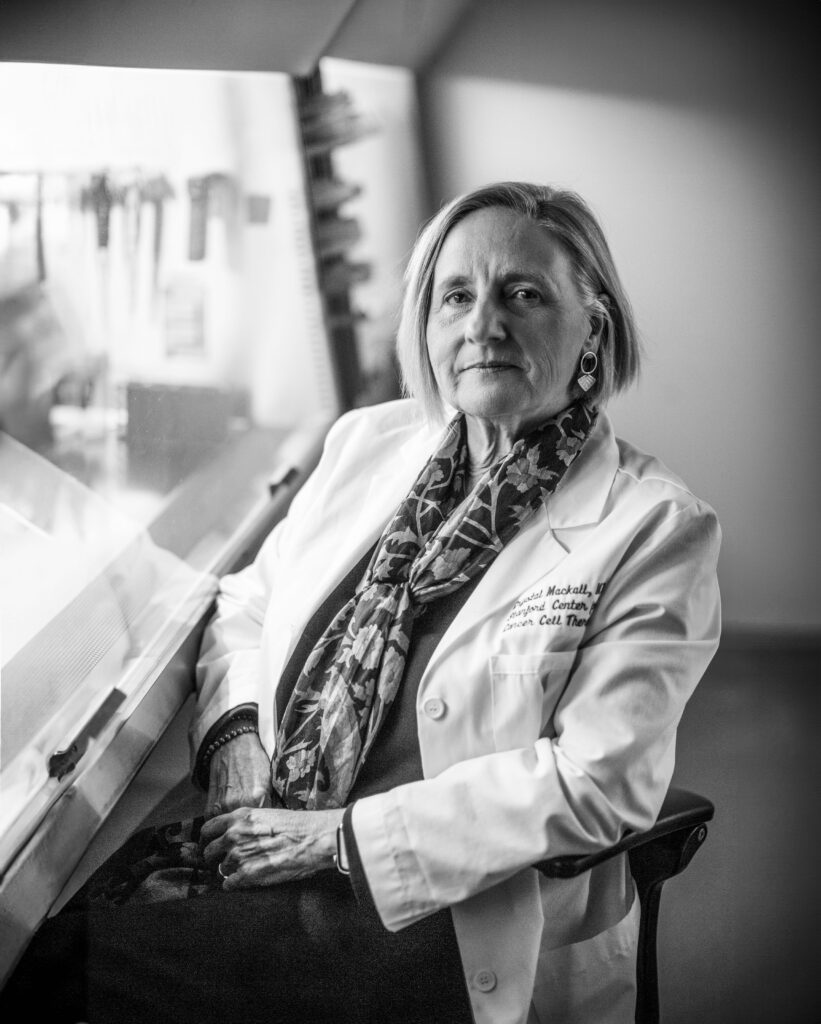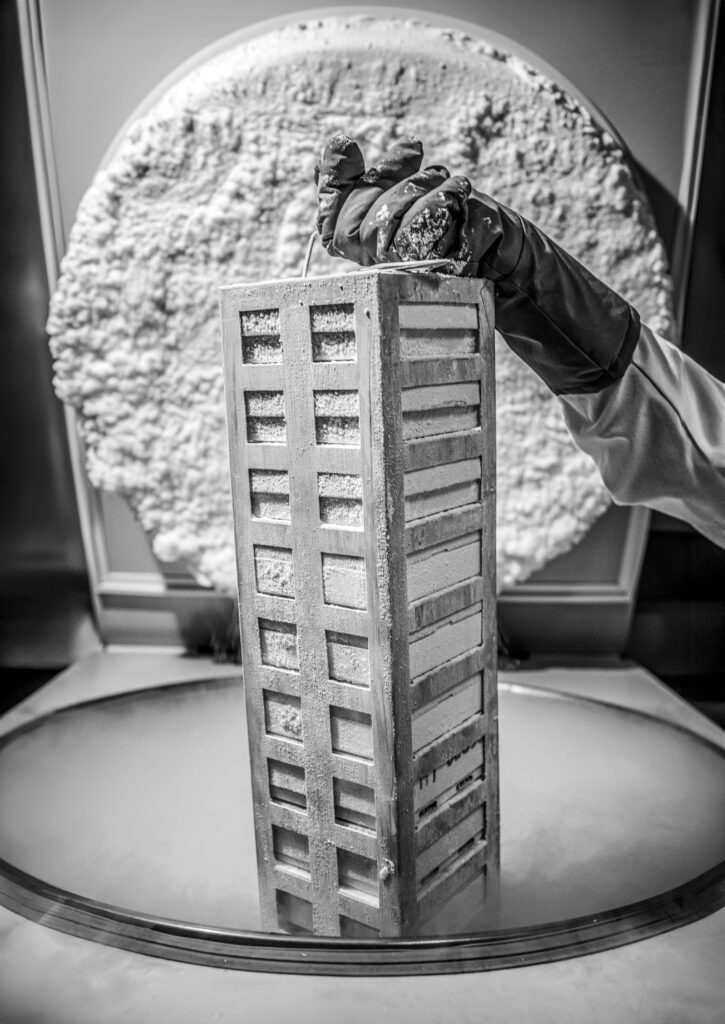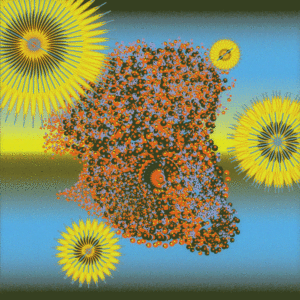Unleashing the immune system
Successes mount for cell therapies, marshaling the body’s bullies to fight cancer

In the early 1990s, professor of pathology and of medicine Edgar Engleman, MD, proposed a way to use immune cells to fight cancers by isolating them from a patient and exposing them to proteins found on the surface of tumor cells. Infusing these treated cells back into the person from whom they were obtained might help the immune system recognize and destroy the cancer cells, he theorized.
His idea wasn’t well received.
“People viewed the whole concept as somewhere between crazy and ‘Are you kidding me?’” Engleman recalled.
At the time, cancer was thought to be primarily a genetic problem: Genes encoding proteins involved in controlling cell growth were mutated as DNA was copied during cell division, and those mutations interfered with their normal function and caused runaway cell division. Find a way to restore that protein’s function and voilà — a new cancer therapy!
The idea that the immune system could be weaponized to fight tumors was often dismissed by all but the most fringe researchers.
But Engleman, who at the time was the director of the Stanford Blood Center, persisted, and in 2010 his cell-based therapy for prostate cancer was the first immunotherapy approved by the U.S. Food and Drug Administration. In the years since, more cell-based cancer therapies have exploded onto the scene.
In 2016, members of the blue-ribbon panel for the White House Cancer Moonshot effort named immunotherapy as one of 10 top research recommendations poised to transform cancer care in the United States. The goal of Moonshot was to make a decade’s worth of progress in cancer prevention, diagnosis and treatment in five years.

And in 2017, Crystal Mackall, MD, the Ernest and Amelia Gallo Family Professor and a professor of pediatrics and of medicine, launched the Center for Cancer Cell Therapy to bring together clinicians, surgeons, researchers, regulatory experts and data scientists to develop and test new cell-based therapies for blood and solid tumors.
Their efforts have led to remarkable clinical milestones, including a promising new treatment for high-risk lymphomas and a way to combat what has been a universally fatal brain tumor in children — each of which has been selected by the FDA for a fast-track review process restricted to particularly promising potential drugs. And in March 2024, Stanford Medicine was the first center in the nation to treat a patient with advanced metastatic melanoma with the first FDA-approved cell-based therapy for solid tumors.
“Ten years from now, we’re going to have cell-based therapies not just for cancers, but also for conditions like autoimmune diseases,” Mackall said. “The manufacturing process will be less onerous and less expensive. And the cells themselves will be more sophisticated, more powerful and safer.”
Although these therapies are currently used only in patients who have either not responded or have seen their cancers recur after standard treatments, in part because the side effects or the preparation for treatment can be harsh, there is hope that new advances will make them easier to tolerate and safe enough to be used as a first option for newly diagnosed cancer patients.
“The future of cancer immunotherapy is bright,” Engleman said. “I’m highly optimistic that we will see the day when cancers of all types are highly curable. Absolutely.”
An early success for immunotherapy
The Center for Cancer Cell Therapy brings together experts of all stripes to navigate a landscape of evolving knowledge about cancer biology, patient responses to treatment and regulatory requirements that must be met to transform cells into safe, effective medicines.
But in the mid-1990s, Engleman worked in a much different environment. At the time, the FDA did not regulate cell-based medicines — mostly because they were relatively unheard of outside of bone marrow transplants. As founder and director of the Stanford Blood Center, Engleman had for years overseen the use of blood products for transfusions.
“I knew transfusions were safe,” he said. He reasoned taking immune cells from a person and returning them to the same person was also likely to be safe.
“The future of cancer immunotherapy is bright. I’m highly optimistic that we will see the day when cancers of all types are highly curable. Absolutely.”
Edgar Engleman, MD
Engleman focused on immune cells called dendritic cells, which display bits of infected or sickly cells to other immune cells like the Vanna White of the immune system. Other immune cells learn from the dendritic cells’ cues how to recognize and kill these compromised cells, stopping infection or disease in its tracks.
“Dendritic cells are by far the most potent immune-stimulating cells in the body,” Engleman said. “So, once my lab developed a way to purify them from blood and showed that they could stimulate other immune cells in the laboratory, I came up with the idea to remove them from a patient, expose them in the lab to bits of proteins called antigens expressed by the tumor, then put them back into the patient. It was a simple, testable idea.”
Bedecked with cancer antigens, the treated cells, Engleman hoped, would spark other immune cells to attack the cancer.

It stores and maintains, at -120°C, healthy donor T cells and cancer cell lines, and tumor samples from pediatric patients. Researchers use T cells to generate CAR-T cells, then engineer and test them to enhance their anti-tumor potency.
Armed with the approval of an internal group that reviews the ethics and processes of experiments that involve animals or humans and the consent of the participants, Engleman and Ronald Levy, MD, the Robert K. and Helen K. Summy Professor in the School of Medicine, tested the theory in four people with a blood cell cancer called B-cell lymphoma. Each of the four developed a measurable immune response to their cancers. One patient’s tumor disappeared, a second patient’s tumor shrank and a third patient’s cancer became undetectable even by sensitive molecular analysis.
“This treatment was a long shot, but these patients were otherwise going to die,” Engleman said. “The fact that it worked was crazy, particularly since the number of dendritic cells we were able to isolate was vanishingly small — on the order of 2 million — versus the billions of other immune cells in the body.”
That pilot study formed the foundation for subsequent research aimed at removing cells from a patient, manipulating them in the laboratory, then returning them with a fresh new ability to fight cancer.
“We could obtain, purify, maintain the viability and infuse them back into the patient in relatively uncomplicated manner, and those manipulated cells had significant effect on the patient. This is a direct forerunner to the types of cell-based therapies we see today,” Engleman said.
Two ways to rouse the immune system
Cell-based cancer treatments come in two flavors. One involves removing cells from the patient, tinkering with them in a laboratory and infusing them back into the body — hopefully with a new ability to track down and eliminate cancer cells. The other relies on using injected proteins or drugs to activate immune cells to fight cancer without removing them from the patient.
The first approach allows fine-tuning of the cells’ anti-cancer activities to a degree that is not possible in their natural environment. Cells captive in a laboratory dish are more accessible, and more vulnerable to biological and genetic tinkering, than their free-range brethren. But these personalized cell therapies — tailor-made for each patient — are also much more expensive. A single treatment for one person can cost hundreds of thousands or even millions of dollars.
“Ten years from now, we’re going to have cell-based therapies not just for cancers, but also for conditions like autoimmune diseases.”
Crystal Mackall, MD
One type of personalized therapy that has gained attention is chimeric antigen receptor T cells, or CAR-T cell therapies. For the therapy, immune cells called T cells are removed from a patient and genetically engineered to express a structure on their surface that can recognize and attach to specific proteins on cancer cells, marking them for destruction.
First approved by the FDA in 2017 for treatment of acute lymphoblastic leukemia in children and young adults, CAR-T cell therapy has led to some remarkable cures, but only in a minority of people. It has since been approved for the treatment of some types of lymphomas and another type of blood cancer called multiple myeloma. But for every success story there are setbacks.
“As effective as it is, this approach is failing more than half the patients,” Mackall said. “We want to understand why they are relapsing, why it doesn’t work all the time. We can learn so much by looking at samples from these patients — a kind of reverse translation where we take what we learn in the clinic back to the laboratory bench to optimize potential therapies.”
Learning from experience
By studying CAR-T cell therapy patients’ samples, the center’s researchers and clinicians learned that the problem was twofold. In many cases, the cancer cells evaded the manipulated T cells by reducing the amount of the target protein displayed on their cell surfaces, scooting under the T cell radar.
Additionally, the T cells are often unable to maintain the ongoing killing frenzy required to successfully eradicate a tumor. Circumventing this T cell exhaustion is a primary goal in CAR-T cell therapy — and one that is thought to be critical to enhancing its success against solid tumors.
The first five CAR-T cell therapies approved by the FDA targeted a protein on cancer cells called CD19,” Mackall said. “We found that in large B-cell lymphoma, these therapies were failing because the cancer cells stopped making CD19. So we targeted a different protein called CD22.”
A Phase 1 clinical trial of patients with cancers that returned after CAR-T therapy targeting CD19 found that switching the target to CD22 is a promising approach. More than half of the 38 people enrolled in the trial — 37 of whom had already relapsed from the original CAR-T therapy — were alive more than two years after treatment. Most of the patients had received multiple lines of therapy, and their life expectancies before joining the trial were less than six months.
“This is one of the worst types of cancer there is. It is 100% fatal, and there is nothing we can offer these patients other than palliative radiation therapy. Imagine walking into an exam room to tell a parent their child is going to die.”
Mackall
“These patients were out of likely curative options,” said assistant professor of medicine and the trial’s principal investigator Matthew Frank, MD, PhD. “But we saw a very high complete response rate — meaning their cancers became undetectable — that seems durable. I’m loathe to say the word cure, but that is what it looks like for some of these patients.”
Given the study’s promising findings, the FDA designated CD22-targeting CAR-T cells a Breakthrough Therapy in 2022, allowing a fast track to regulatory approval if confirmed by subsequent studies.
“Studying the patient can teach you where to go next, and why,” Mackall said, noting a larger clinical trial is underway.
Last year, another trial of CAR-T cell therapy yielded promising results. This treatment, for a type of uniformly fatal brain tumor in children called diffuse intrinsic pontine glioma (or DIPG), targeted a protein called GD2 on the tumor’s surface.
“This is one of the worst types of cancer there is,” Mackall said. “It is 100% fatal, and there is nothing we can offer these patients other than palliative radiation therapy. Imagine walking into an exam room to tell a parent their child is going to die.”
Michelle Monje, MD, PhD, the Milan Gambhir Professor in Pediatric Neuro-Oncology and professor of neurology at Stanford Medicine, has dedicated much of her career to finding new treatments for DIPG. In 2018, she and her team found GD2 is abundant on the surface of the DIPG cancer cells. Fortuitously, Mackall’s lab had already generated CAR-T cells that target GD2, which also occurs on some other cancers.
After showing success in mice with DIPG, Monje and Mackall launched a small clinical trial in 11 children with DIPG. In November 2024, the researchers reported that of the 11, nine experienced improvements in their neurological function, four had the volume of their tumors reduced by more than half, and in one of those four the tumor disappeared completely.
“This isn’t a home run.The cancers of most of these children are still progressing. But it’s a real sign of significant CAR-T activity and gives hope for clinicians, patients and family members affected by this devastating disease.”
Mackall
“This isn’t a home run,” Mackall said. “The cancers of most of these children are still progressing. But it’s a real sign of significant CAR-T activity and gives hope for clinicians, patients and family members affected by this devastating disease.”
Again, the FDA took notice, designating the GD2-targeting CAR-T therapy for DIPG as a regenerative medicine advanced therapy. As with the CD-22 Breakthrough Therapy, the designation gives access to a fast-track review process reserved for particularly promising treatments.
And in October 2023, clinical professor of neurology and the neurological sciences Reena Thomas, MD, PhD, received $12 million from the California Institute for Regenerative Medicine to support a Phase 1 trial of CAR-T therapy in glioblastoma multiforme — a brain tumor that has a dismal five-year survival rate of less than 10%. Thomas and her colleagues devised a way to deliver the cells — which target a protein on the cancer cells called B7-H3 — directly into the surgery site and cerebral spinal fluid over the course of up to six months.
In addition to sussing out cancer-specific targets for CAR-T cells, researchers and engineers are devising ways to make their delivery to the tumor sites more effective. Researchers in the laboratory of Joseph DeSimone, PhD, professor of radiology and of chemical engineering, are developing a 3D-printed platform to allow precision delivery of CAR-T cells into tumors to enhance their effectiveness and reduce the body-wide side effects that afflict some patients.
A therapy for solid tumors
CAR-T cell therapy isn’t the only game in town, however. Tumor infiltrating lymphocyte therapy, or TIL, was pioneered in the late 1980s by Steven Rosenberg at the National Cancer Institute. Assistant professor of medicine Allison Betof Warner, MD, PhD, helped lead trials of TIL therapy as a junior faculty member at Memorial Sloan Kettering Cancer Center. Rather than relying on researchers to identify a tumor-specific target on a person’s cancer, TIL capitalizes on the fact that T cells in the tumor are likely to be there because they recognize the tumor is something that should be eliminated from the body.
Surgically removing part of a tumor and extracting the T cells inside yields a grab bag of seasoned warriors whose very diversity is a plus. It is difficult for a cancer to simultaneously magic away multiple molecular targets. Over a period of about 35 days, scientists coax these cells to divide repeatedly, expanding their numbers into the billions. Adding these cells back to the patient from whom they were derived sends a legion of tumor-targeting immune cells coursing through the blood — all without the genetic engineering CAR-T cell therapy requires.
In 2024, the FDA approved TIL as a treatment for advanced melanoma patients whose cancers have resisted immunotherapies — the first cell-based therapy approved to treat solid tumors. In March that year, Stanford Medicine was the first center in the nation to treat a patient with the newly approved TIL, known as lifileucel.
“There is a nuance to understanding what types of tumors will be better than others and what tissues are better than others.”
Amanda Kirane, MD, PhD
“Blood cancers like lymphomas usually express CD19 on their surface, but we don’t have those kinds of reliable markers for solid tumors,” Betof Warner said. “We don’t know exactly what markers in the tumor the T cells are recognizing — they probably target many different things. But TIL are naturally occurring nonengineered cells that already recognize the cancer.”
Although melanomas happen to be rich in T cells, Betof Warner and assistant professor of surgery Amanda Kirane, MD, PhD, are testing TIL for other types of solid tumors, including lung. Researchers elsewhere are exploring its use as an initial treatment for metastatic melanoma.
“There is a nuance to understanding what types of tumors will be better than others and what tissues are better than others,” Kirane said. As the surgical lead for the TIL program at the center, she dissects tumor specimens to get at the T cells inside.
Although the diversity of the T cells is a strength of TIL, the researchers are keen to learn exactly which cancer-associated markers draw the most attention from the reinfused T cells.
“We are always looking for ways to make cell therapy better,” Kirane said.
Treating high-risk populations with a novel therapy requires the collaboration of oncologists, neurosurgeons, radiologists, intensive care specialists, researchers and even engineers — all facilitated by the Center for Cancer Cell Therapy.
“The center serves as a nexus to bring together clinical specialists and researchers studying cancers across the campus,” Mackall said. “Advances like these require everyone working together. It’s not just one brilliant scientist toiling over a laboratory bench.”

